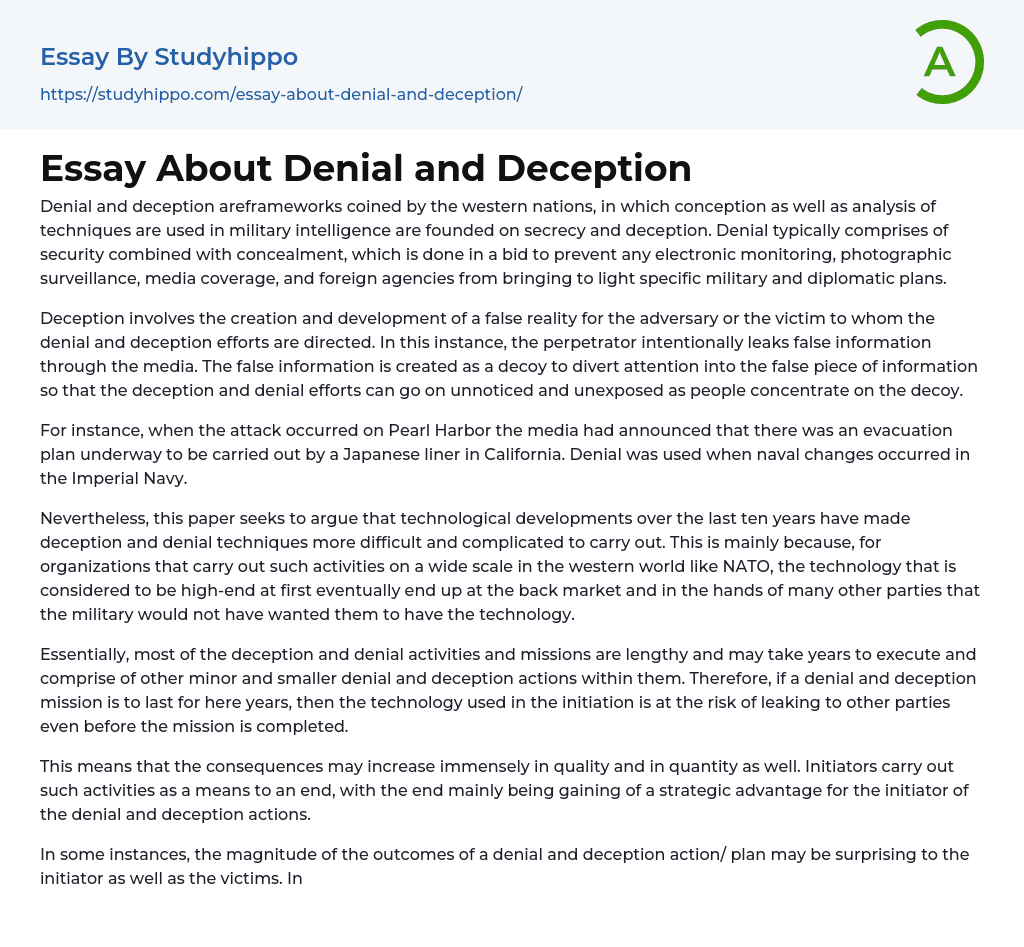Denial and deception areframeworks coined by the western nations, in which conception as well as analysis of techniques are used in military intelligence are founded on secrecy and deception. Denial typically comprises of security combined with concealment, which is done in a bid to prevent any electronic monitoring, photographic surveillance, media coverage, and foreign agencies from bringing to light specific military and diplomatic plans.
Deception involves the creation and development of a false reality for the adversary or the victim to whom the denial and deception efforts are directed. In this instance, the perpetrator intentionally leaks false information through the media. The false information is created as a decoy to divert attention into the false piece of information so that the deception and denial efforts can go on unnoticed and unexposed as people co
...ncentrate on the decoy.
For instance, when the attack occurred on Pearl Harbor the media had announced that there was an evacuation plan underway to be carried out by a Japanese liner in California. Denial was used when naval changes occurred in the Imperial Navy.
Nevertheless, this paper seeks to argue that technological developments over the last ten years have made deception and denial techniques more difficult and complicated to carry out. This is mainly because, for organizations that carry out such activities on a wide scale in the western world like NATO, the technology that is considered to be high-end at first eventually end up at the back market and in the hands of many other parties that the military would not have wanted them to have the technology.
Essentially, most of the deception and denial activities and missions are lengthy and may take years
to execute and comprise of other minor and smaller denial and deception actions within them. Therefore, if a denial and deception mission is to last for here years, then the technology used in the initiation is at the risk of leaking to other parties even before the mission is completed.
This means that the consequences may increase immensely in quality and in quantity as well. Initiators carry out such activities as a means to an end, with the end mainly being gaining of a strategic advantage for the initiator of the denial and deception actions.
In some instances, the magnitude of the outcomes of a denial and deception action/ plan may be surprising to the initiator as well as the victims. In fact, the outcomes make victims realize that the signs of the act were there all along only that they failed to act appropriately in accordance with the available evidence. The outcomes may be in a magnitude more than what was expected by the initiators in the event the victims may have had access to some of the technologies and used the in a way affecting the outcome to a considerable and significant degree.
As much as the new and emerging technologies as a result of wide and immense military research and development are essential in making these denial and deception missions easier to execute and realizable as well as more efficient than previously in history, the lurking danger is that the technology used may become available to other parties.
NATO has itself acknowledged the complexity that comes with executing such actions since they are required to constantly move their troops and equipment as well. This makes the
technologies involved vulnerable and at the risk of exposure to other parties. Unless a cost-effective and secure manner of moving such equipment is derived, denial and deception efforts will continue to be derailed and jeopardized by the same technologies that are developed to make the efforts easier and more efficient.




